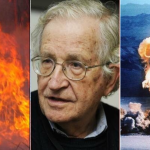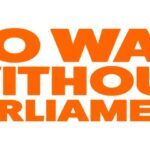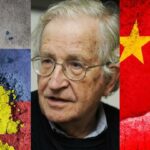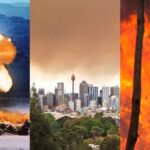As NYC Warns Residents to Be Prepared, Nuclear War Is Closer Than Ever Before
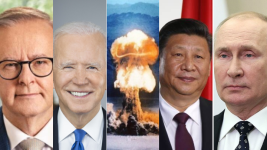
Earlier this month, the New York City Office of Emergency Management released a short public service announcement warning residents in the biggest city in the United States of what they should do in the case of a nuclear attack.
The NYC emergency office hasn’t outlined why producing such an advertisement was warranted at present, however, over the last year, the talk of nuclear weapon use has escalated, especially in terms of Russia’s statements since it invaded Ukraine.
In a recent piece about NATO expansion and rising existential threats, US journalist Chris Hedges asserts that “at no time, including the Cuban missile crisis, have we stood closer to the precipice of nuclear war”.
“The big one has hit,” says the announcer during the NYC nuclear preparedness clip. “So, what do we do?” She then goes on to relate the “three important steps”: get inside fast, stay inside and get clean immediately and then stay tuned to the media for more information.
However, if a nuclear warhead exploded over the Sydney CBD, rushing inside your Surry Hills apartment likely won’t save you, and while the nuclear threats arising out of the war in Ukraine don’t focus on our region, the current build-up in the Indo Pacific does raise concerns.
The potential for escalation
As Russia began its invasion of neighbouring Ukraine on 24 February, the nation’s president Vladmir Putin warned the globe that “anyone… interfering from the outside… will face consequences greater than any you have faced in history”, which was a thinly veiled threat of nuclear retaliation.
Within a few days of the now five-month-old conflict beginning, the Kremlin had placed its nuclear force on high alert and its troops attacked a large Ukrainian nuclear facility in early March.
Putin again threatened to use nuclear weapons to protect Russian sovereignt just last month.
Some commentators have put these threats down to bravado. But Vladmir’s provocative assertions involve the intention to use weapons that can wipe out humanity, while, for his part, US president Joe Biden said such moves are “completely unacceptable” and would “entail severe consequences”.
The Obama administration in 2016 considered appropriate responses to Russia invading a NATO country in the Baltic and using a nuclear weapon upon it. And one committee found the US would have to retaliate by dropping a nuke on Belarus, as a Russian ally, despite its non-involvement.
The potential for this situation to escalate seems likely to continue as the US appears to be conducting a proxy war against Russia via the funding of Ukrainian troops, in an attempt to bog Moscow down in an entrenched conflict that drains its resources, like Vietnam did to Washington.
Closing in on doomsday
Nine nations possess nuclear weapons: Russia, the US, the UK, France, China, India, Pakistan, North Korea and Israel. The first five countries listed are known as the nuclear-weapons states, as their possession of stockpiles are officially recognised under the Nuclear Non-Proliferation Treaty.
Via a joint statement, the five nuclear-weapons states reconfirmed their adherence to the treaty in January. However, by mid-March, Russia had violated its terms, as it had attacked Ukraine, a country which has given up nuclear weapons, as well as having targeted nuclear facilities in attacks.
Currently, there are around 13,080 nuclear warheads known to be in existence, with the arsenals in Russia and the United States accounting for 90 percent of them. Moscow has 6,257 nuclear weapons in its stockpile, while Washington has 5,550 such bombs.
The Bulletin of Atomic Scientists has run the Doomsday Clock since 1947. The nearer the minute hand is set to midnight marks the closeness to humanity’s end.
The clock has been set at 100 seconds to midnight since 2020, the closest it has ever been, due to the dual concerns of nuclear annihilation and climate change.
Flashpoint in the Pacific
The announcement of the AUKUS (Australia, the UK and the US) pact last September, was another significant nuclear development, as the agreement, which targets China, involves our nation acquiring eight nuclear-powered submarines built using secret US technology.
This provocation was not lost upon Beijing, which warned via its mouthpiece the Global Times, that in siding with “the US in the China-US strategic game, Australia has turned itself into an adversary of China”, and if our nation continues in this manner, “China will certainly punish it with no mercy”.
Australian peace activist Jacob Grech told Sydney Criminal Lawyers in October that the wording of the Global Times was significant as another editorial two months prior had warned China would attack Australia with conventional weapons but since AUKUS, the word “conventional” was missing.
And the People’s Daily Online reported last week, that a Chinese academic report has asserted that AUKUS “constitutes a blatant act of nuclear proliferation” as the submarine collaboration sets “a dangerous precedent for the illegal transfer of weapons-grade nuclear materials”.
Over its last 12 months in office, the Morrison government escalated its war on China rhetoric. Then defence minister Peter Dutton went as far as to commit our nation to following Washington into a conflict with Beijing over Taiwan, which, Hedges asserts, is the White House’s endgame.
Since the Albanese administration took over the reins two months ago, it has acted to improve diplomatic ties with Beijing, yet it’s also been goading the East Asian nation in line with the aggressive stance of Washington.
PM Anthony Albanese has made persistent comments about Beijing’s aggression in the Indo Pacific. His first action as top minister was to attend a meeting of the Quad, an alliance consisting of the US, Japan, India and Australia, which again, has China as its focus.
Albanese further attended a NATO meeting last month. Held in Madrid, the conference involved a handful of nations from the Indo Pacific for the first time, marking the alliance’s move into our region, as previously evidenced with the AUKUS announcement.
The world leaders gathered in Spain for the North Atlantic Treaty Organisation meeting went on to condemn Russia for its invasion of Ukraine, and then identified China as a threat, which was a first for the alliance over its more than seven decade history.
The dread gap
Professor Noam Chomsky recalled on Wednesday that when it was announced that a nuclear bomb had destroyed Hiroshima on 6 August 1945, it “struck him very sharply” that, after brief exhalation about the end of the world war, the people around him simply went back to business as usual.
Chomsky explained that despite human intelligence having “reached the capacity for total destruction” people failed to pay attention. He’s described this as the “dread gap”: the disconnect between “our technical capacity to destroy and our moral capacity to control this impulse”.
And this is why the minute hand on the Doomsday Clock is continuing to creep forward.
“Don’t forget to sign up for Notify NYC for official updates,” the woman who features in the New York City nuclear preparedness public service announcement says towards the end of clip.
“And don’t go outside until officials say it’s safe,” she further advises city residents, before assuring them, “Alright, you’ve got this”.


